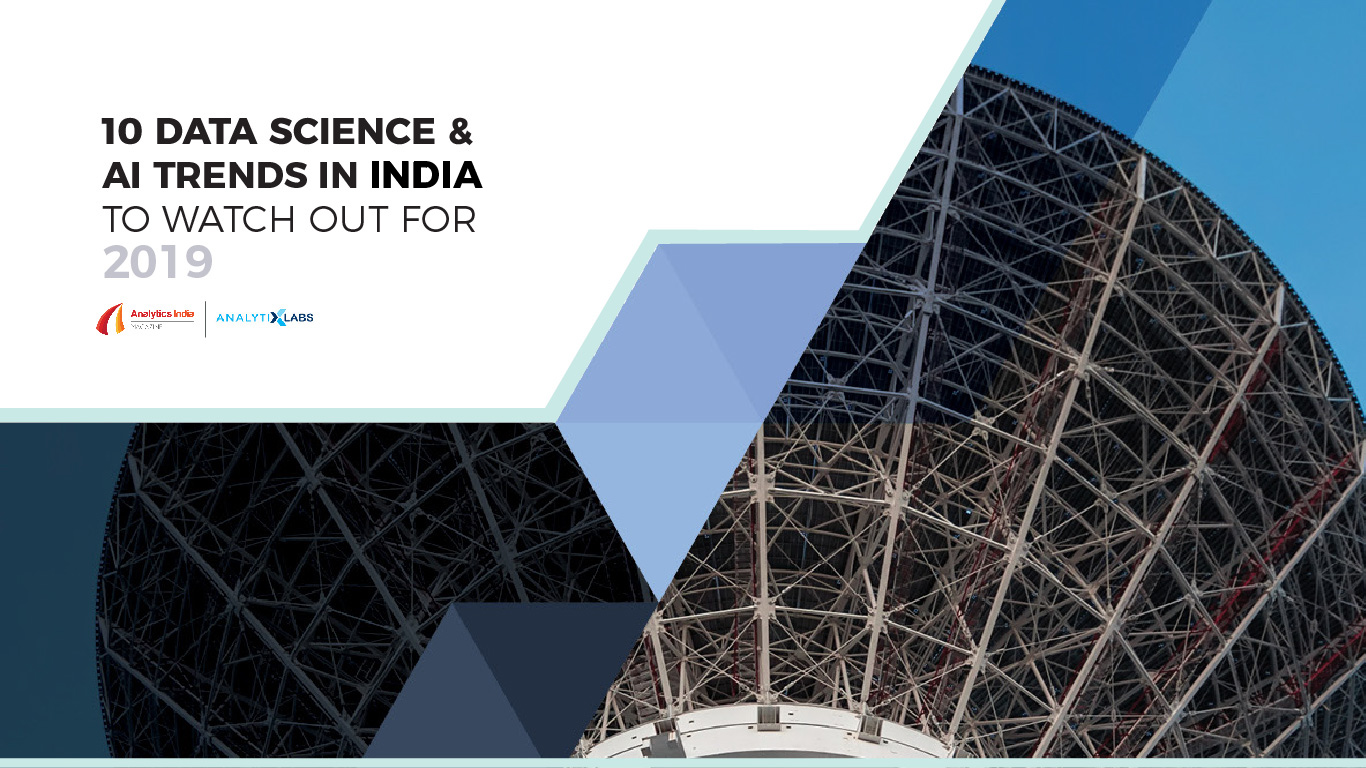With enterprises putting digital at the core of their transformation, our annual Data Science & AI Trends Report explores the key strategic shifts enterprises will make to stay intelligent and agile going into 2019. The year was marked by a series of technological advances, including advances in AI, deep learning, machine learning, hybrid cloud architecture, edge computing (with data moving away to edge data centres), robotic process automation, a spurt of virtual assistants, advancements in autonomous tech and IoT.
With data championing technological innovation, analytics and AI has proven to be a competitive advantage for businesses across functions, such as sales, marketing, finance, customer service and IT.
Today, Data Science and AI have seeped into many business functions and we are seeing increased collaborations between leading companies and Data Science Service Providers, specialising in providing tailored solutions. Another key takeaway is how companies are planning to increase their IT budgets on analytics and data science.
A majority of our respondents believe the growing adoption of AI and analytics has become a game changer across business functions and there will be an uptick in niche sectors such as sports. A key trend this year was core business processes being redesigned around AI to deliver advantages beyond cost savings. RPA has been widely deployed to automate well-defined, rule-based tasks and the spurt of virtual assistants in banking has spawned a new age of Conversational AI in finance. On the other end of the spectrum, we will see an increased AI-cloud interdependency which in turn will fuel the growth of public cloud companies. Organisations are also realising the benefits of cognitive technologies to provide better insights. This year we collaborated with AnalytixLabs, a leading Data science training institute to bring out key trends.
Check Out The Top Trends In Analytics And Data Science To Dominate In 2019
Trend #1: More Industries Are Going To Utilise Analytics & AI In A Big Way
Enterprises in 2019 and beyond will continue to focus on advanced solutions and adopt technologies like artificial intelligence and machine learning to deliver better customer experience. The technology landscape will also transition to an API-based economy with AI and analytics becoming more pervasive.
In the coming year too, more and more industries and services including automotive, healthcare, broadcast and telecommunications, education, finance, consumer electronics and multimedia will adopt and implement AI to enhance customer experience, optimise and automate processes.
-Nitin Pai, Senior Vice-President, Head of Marketing and Strategy, Tata Elxsi
AI in the Automobile segment is showcasing Automated Guided Vehicles (AVGs) to move materials around automotive plants. Multi-recognition systems monitor and analyse data to derive driver’s attentiveness or excitement level. AI enabled wearable IOT sensors such as H-Vex to protect the workforce ensuring safety and increased productivity.
-Dr Muthukumaran Balasubramanian, Head – BigData, HTC Global Services
 While we have seen industries like financial services, consumer product goods, telecom, healthcare etc. embracing analytics in their decision making, the adaptation of data-driven decisions will see an increased application in sports in different areas from performance analysis to fan engagement.
While we have seen industries like financial services, consumer product goods, telecom, healthcare etc. embracing analytics in their decision making, the adaptation of data-driven decisions will see an increased application in sports in different areas from performance analysis to fan engagement.
-Indranath Mukherjee, AVP, Head, Strategic Analytics, AXA XL
 In 2019, Credit Risk Analytics will deep dive in the Lending algorithm of New to Credit (NTC) using latest AI/ML tools. While several fintechs have come up with incremental data enrichment for this segment, Banks & NBFCs will soon see a crystallised analytical way of managing NTC customers through advanced analytics.
In 2019, Credit Risk Analytics will deep dive in the Lending algorithm of New to Credit (NTC) using latest AI/ML tools. While several fintechs have come up with incremental data enrichment for this segment, Banks & NBFCs will soon see a crystallised analytical way of managing NTC customers through advanced analytics.
-Anand K Sundaram, GEVP- Data Analytics Center, YES BANK
 The acceptance of AI, ML & DL started to happen in the last few months and now will become the key to solve business problems making it the way of life at organisations adopting analytics. The acceptance and application will increase significantly in global and Indian context solving business problems, developing new use cases and developing innovative products & solutions based on that.
The acceptance of AI, ML & DL started to happen in the last few months and now will become the key to solve business problems making it the way of life at organisations adopting analytics. The acceptance and application will increase significantly in global and Indian context solving business problems, developing new use cases and developing innovative products & solutions based on that.
-Gurpreet Singh, Director & Founder, G-Square Solutions
Trend #2: Deploying Models For Real-time Use-cases
The emergence of real-time analytics has become the key to unlock insights and up to 70 percent of organisations have increased their spending on real-time analytics. The shift towards real-time analytics is spurred by the growth in the number of connected devices, which has driven enterprises towards real-time edge analytics which is helpful in finding correlations and hidden patterns, in turn helping business leaders make better, informed decisions. In a similar vein, the rapid development of connected devices and IoT applications has pushed centralised cloud computing to the edge.
 In consumer Internet companies such as from the domain of e-commerce, machine learning models are being deployed into the real-time serving infrastructure, whereby based on the user’s actions within the session, propensity scores are being computed to determine the best set of product recommendations along with dynamic pricing. This is being enabled by building models using batch data, but performing scoring in real-time. The challenges are how to employ models with enough sophistication to make a significant impact, yet have a low latency response to the in-session scoring.
In consumer Internet companies such as from the domain of e-commerce, machine learning models are being deployed into the real-time serving infrastructure, whereby based on the user’s actions within the session, propensity scores are being computed to determine the best set of product recommendations along with dynamic pricing. This is being enabled by building models using batch data, but performing scoring in real-time. The challenges are how to employ models with enough sophistication to make a significant impact, yet have a low latency response to the in-session scoring.
-Nitin Seth, CEO, Incedo Inc.
 With the explosion in the number of IoT devices, there is a need to harness the power of sensor data to produce meaningful real-time insights. In 2019, move from batch to stream data processing to get real-time actionable insights is going to be massive. More and more companies will look for real-time data analysis for events that need to be detected right away and responded to quickly.
With the explosion in the number of IoT devices, there is a need to harness the power of sensor data to produce meaningful real-time insights. In 2019, move from batch to stream data processing to get real-time actionable insights is going to be massive. More and more companies will look for real-time data analysis for events that need to be detected right away and responded to quickly.
-Akhilesh Ayer, Head, Research & Analytics, WNS
 Real-time analytics will be another disruptor in the coming years, we haven’t seen much of it yet. This means using runtime data from dashboards to make decisions. One good use case could be traffic monitoring for designing intelligent street parking systems.
Real-time analytics will be another disruptor in the coming years, we haven’t seen much of it yet. This means using runtime data from dashboards to make decisions. One good use case could be traffic monitoring for designing intelligent street parking systems.
-Mohit Kapoor, CEO, DBS Asia Hub 2 (DAH2)
Trend #3: Data Analysis And Informed Customer Space
2019 will be the year when organisations will put “consumer” at the heart of digital transformation. Going forward, consumers will become a part of the larger strategy around digital transformation with enterprises building new business models to engage users better. The study forecasts a trend where enterprises will put data back into the hands of users – the real “data owners” to drive better user experiences.
 The business environment for the insurance industry has been challenging. Data will build the foundation for an effective customer engagement strategy of insurance firms. The two major segments of analytics in the online space – group dynamics and individual behaviour, will continue to impact the process of detailed analysis, product development, personalised insurance products, strategy and creating customer-connect campaigns accordingly.
The business environment for the insurance industry has been challenging. Data will build the foundation for an effective customer engagement strategy of insurance firms. The two major segments of analytics in the online space – group dynamics and individual behaviour, will continue to impact the process of detailed analysis, product development, personalised insurance products, strategy and creating customer-connect campaigns accordingly.
-Vijay Sinha, MD & CEO, COCO by DHFL General Insurance
 As opposed to today’s scenario, customer data ownership will move from businesses and back towards customers. We foresee new services that will emerge and empower customers to monetise their data and rent it to companies, with the capability to withdraw its use when they decide to. Since data is the fuel behind powering AI, customers will begin to realise the power they have to drive their AI-based experiences with data control and data management practices.
As opposed to today’s scenario, customer data ownership will move from businesses and back towards customers. We foresee new services that will emerge and empower customers to monetise their data and rent it to companies, with the capability to withdraw its use when they decide to. Since data is the fuel behind powering AI, customers will begin to realise the power they have to drive their AI-based experiences with data control and data management practices.
-Suman Reddy Eadunuri, MD & Country Head, Pegasystems India
 In the past machine learning output, especially deep learning output was more of a black box as far as providing an explanation to the users of the product/system. However, more and more machine learning systems are evolving to also provide a tie into user’s history or behaviour in addition to providing the actual product recommendation. With this tie-in, the users get a context of why something is being recommended to them, and are not surprised by particular user experiences presented to them by the consumer Internet company/interface. This is very important to retain the user’s trust in the company.
In the past machine learning output, especially deep learning output was more of a black box as far as providing an explanation to the users of the product/system. However, more and more machine learning systems are evolving to also provide a tie into user’s history or behaviour in addition to providing the actual product recommendation. With this tie-in, the users get a context of why something is being recommended to them, and are not surprised by particular user experiences presented to them by the consumer Internet company/interface. This is very important to retain the user’s trust in the company.
-Nitin Seth, CEO, Incedo Inc
Trend #4: More Investment In Enterprise-Grade Data Infrastructure, Platforms & Cloud
With increased investment in cloud and quantum computing, business leaders emphasise an increasing AI interdependency on the cloud. In fact, we believe AI services have fuelled the growth of public cloud providers, especially AWS, Microsoft, Google and Alibaba. Going into 2019, we will see an increased AI-cloud interdependency and as we observed in 2018, leading cloud giants are pursuing an AI-lock in approach by providing open source AI-related services. The next year will see AI platforms dominating the public cloud market and cloud providers, especially Google, AWS and Microsoft will further expand their AI cloud portfolio. A key reason why enterprises are leaning towards public cloud is that it is impossible to build in-house, scalable AI systems and the general sentiment is that AWS leads in the cloud and AI deployments.
 2019 will witness increased growth of Big data platforms into medium & small size organisations. Big data prominence over the last few years has led to the generation of an enormous amount of data. This data has a colossal potential for analysing existing and new consumer patterns, research, identifying new trends etc. Converting data potential to reality will need an exponentially improved speed of computing, hence the rise of quantum computing. Companies have started investing in this space, however, results are yet to be seen.
2019 will witness increased growth of Big data platforms into medium & small size organisations. Big data prominence over the last few years has led to the generation of an enormous amount of data. This data has a colossal potential for analysing existing and new consumer patterns, research, identifying new trends etc. Converting data potential to reality will need an exponentially improved speed of computing, hence the rise of quantum computing. Companies have started investing in this space, however, results are yet to be seen.
-Sudhanshu Singh, Senior Vice President, Analytics and Research, Genpact
 Public clouds will increasingly be the host platform for AI, will evolve to reduce complexity, and will have reduced reliance on IT departments. Powerful GPU instances, flexible storage options, and production-grade container technology are just a few of the reasons that AI applications are increasingly cloud-based. For engineers and scientists, cloud-based development eases collaboration and enables on-demand use of computing resources rather than buying expensive hardware with a limited lifespan. Cloud, hardware and software vendors are recognising, however, that this technology stack is often difficult for engineers and scientists to set up and use in their development workflow.
Public clouds will increasingly be the host platform for AI, will evolve to reduce complexity, and will have reduced reliance on IT departments. Powerful GPU instances, flexible storage options, and production-grade container technology are just a few of the reasons that AI applications are increasingly cloud-based. For engineers and scientists, cloud-based development eases collaboration and enables on-demand use of computing resources rather than buying expensive hardware with a limited lifespan. Cloud, hardware and software vendors are recognising, however, that this technology stack is often difficult for engineers and scientists to set up and use in their development workflow.
-Paul Pilotte and Bruce Tannenbaum, heads – Data Analytics and AI marketing, MathWorks
Trend #5: Analytics & AI Is Becoming Increasingly Pervasive & Transparent
2018 was a year when analytics and AI showed serious commercial applications and usability. We have observed a shift how technology companies are using AI and analytics to significantly improve their marketplace opportunities. As we move forward in 2019, we see an emergence of cognitive technologies, which go beyond automation to computer vision, deep learning and language technologies which include speech recognition, sentiment and text analytics, natural language processing and generation. As we press forward, we will see a rich ecosystem of platform companies offering AI applications with high business value.
 AI is gaining a nearly ubiquitous presence, and machine learning and deep learning are getting more sophisticated. As we enter 2019, we will see a rise of AI and cognitive platforms aimed to help businesses mine and analyse massive amounts of unstructured data (in form of text, images, and videos) to derive actionable insights, a thing we’ve not been able to unlock in the past. With this greater depth, we could see more commercial use cases of image and speech analytics in the nearer term.
AI is gaining a nearly ubiquitous presence, and machine learning and deep learning are getting more sophisticated. As we enter 2019, we will see a rise of AI and cognitive platforms aimed to help businesses mine and analyse massive amounts of unstructured data (in form of text, images, and videos) to derive actionable insights, a thing we’ve not been able to unlock in the past. With this greater depth, we could see more commercial use cases of image and speech analytics in the nearer term.
-Akhilesh Ayer, Head, Research & Analytics, WNS
 As AI Augmented analytics (predictive & prescriptive) becomes more mainstream, there’s going to be a much wider audience than the data scientists that it was previously limited to. How do you get every employee, who may have never directly accessed data, or has years of “experience” under their belt, begin to trust a prediction or recommendation that analytics software gives them? AI will need to be transparent. Narrative storytelling & explanations on how the software came to a prediction will replace static charts and numbers. AI will need to be measurable. Automated feedback loops that self-report differences between actuals and predicted metrics and drive retraining of the models will be standard features in any AI augmented analytics product. AI will need to be held accountable. Concepts such as “protected variables” (zip code, gender) to prevent bias entering models will be the top 5 requirements in an RFP. Analytics products without these features will not be able to gain the trust of the end users and thus ROI and adoption will suffer.
As AI Augmented analytics (predictive & prescriptive) becomes more mainstream, there’s going to be a much wider audience than the data scientists that it was previously limited to. How do you get every employee, who may have never directly accessed data, or has years of “experience” under their belt, begin to trust a prediction or recommendation that analytics software gives them? AI will need to be transparent. Narrative storytelling & explanations on how the software came to a prediction will replace static charts and numbers. AI will need to be measurable. Automated feedback loops that self-report differences between actuals and predicted metrics and drive retraining of the models will be standard features in any AI augmented analytics product. AI will need to be held accountable. Concepts such as “protected variables” (zip code, gender) to prevent bias entering models will be the top 5 requirements in an RFP. Analytics products without these features will not be able to gain the trust of the end users and thus ROI and adoption will suffer.
-Ketan Karkhanis, GM of Einstein Analytics, Salesforce
 Businesses are realising that analytics competency cannot be built within a silo in the organisation. Everyone has to talk the language of data. Everyone has to be data savvy. 2019 will be the year that everyone becomes ‘Data Smart’. Data literacy for everyone in the organisation is going to be the mantra for 2019.
Businesses are realising that analytics competency cannot be built within a silo in the organisation. Everyone has to talk the language of data. Everyone has to be data savvy. 2019 will be the year that everyone becomes ‘Data Smart’. Data literacy for everyone in the organisation is going to be the mantra for 2019.
-Gaurav Vohra, Co-founder & CEO, Jigsaw Academy
Trend#6: Complexity Necessitates Greater Collaboration
The transforming nature of technology and the changing dynamics will necessitate increased collaborations between engineering teams and data scientists. As we inch towards 2019, business leaders lay down the friction points in product lifecycle management, the complexity of projects and lack of expertise which will have to be resolved to simplify workflows and improve results. What we observed in 2018 was a high adoption of new tools which helped in setting up templates and simplifying workflows and coding.
 The increased use of machine learning and deep learning in complex systems will necessitate many more participants and greater collaboration. Data collection, synthesis and labelling are increasing the scope and complexity of deep learning projects, requiring larger and decentralised teams. Systems and embedded engineers will require flexibility to deploy inference models to data centres, cloud platforms, and embedded architectures such as FPGAs, ASICs, and microcontrollers. These teams will also need expertise in optimisation, power management and component reuse. Engineers at the centre of collaboration, developing deep learning models, will need tools to experiment and manage the ever-growing volumes of training data and lifecycle management of the inference models they handoff to system engineers.
The increased use of machine learning and deep learning in complex systems will necessitate many more participants and greater collaboration. Data collection, synthesis and labelling are increasing the scope and complexity of deep learning projects, requiring larger and decentralised teams. Systems and embedded engineers will require flexibility to deploy inference models to data centres, cloud platforms, and embedded architectures such as FPGAs, ASICs, and microcontrollers. These teams will also need expertise in optimisation, power management and component reuse. Engineers at the centre of collaboration, developing deep learning models, will need tools to experiment and manage the ever-growing volumes of training data and lifecycle management of the inference models they handoff to system engineers.
–Paul Pilotte and Bruce Tannenbaum, heads – Data Analytics and AI marketing, MathWorks
 As data science teams grow, the need for collaboration and version control will become paramount. General purpose engineering tools like Git, JIRA, Trello etc. would become more and more important for data scientists. Also, new tools specific to data science collaboration would get adopted – some of them are already popular – such as mode studio or dbt.
As data science teams grow, the need for collaboration and version control will become paramount. General purpose engineering tools like Git, JIRA, Trello etc. would become more and more important for data scientists. Also, new tools specific to data science collaboration would get adopted – some of them are already popular – such as mode studio or dbt.
-Ankur Sharma, VP, Analytics, Instamojo
Trend #7: Personalised Products
AI-driven personalisation has become the answer to marketers’ woes and the growing use of analytics and AI is helping businesses to deliver customised communications and services. There is a growing usage of customer segmentation and data to better understand user behaviour and deliver a curated set of services in real-time to serve consumers. Especially in the financial sector, there is a growing uptick in the adoption of analytics to rethink customer engagement and the segmentation approaches.
 Customers prefer personalised insurance covers instead of the one-size-fits-all products. Flexible coverage options, micro insurance and peer-to-peer insurance are becoming viable options. Lifestyle apps are re-imagining the insurer-insured relationships. APIs are enabling the creation of insights-driven offerings as they integrate data from multiple sources. Premiums will become highly personalised, enabled by new sources of tech-enabled data such as the Internet of Things, mobile-enabled InsurTech apps and wearables.
Customers prefer personalised insurance covers instead of the one-size-fits-all products. Flexible coverage options, micro insurance and peer-to-peer insurance are becoming viable options. Lifestyle apps are re-imagining the insurer-insured relationships. APIs are enabling the creation of insights-driven offerings as they integrate data from multiple sources. Premiums will become highly personalised, enabled by new sources of tech-enabled data such as the Internet of Things, mobile-enabled InsurTech apps and wearables.
-Anand Pejawar, President-Operations, IT & International Business, SBI Life Insurance
Some lenders are already personalising the targeting for sourcing loan applications. However, we are yet to see personalised interest rates beyond broad segments. We are headed towards a world of ultra-personalisation where a loan’s approval, the amount, and the interest rate would depend on the applicant characteristics, the purpose of the loan, the tenure requested, and the external environmental factors of that time.
- Pre-loaded/Dynamically-loaded EMI cards with personalised interest rates will become more ubiquitous
- Personalised restructuring of loans/add-on loans will become a norm
- P2P lending and newer NBFCs in the form of start-ups and big-tech will increasingly compete with traditional banks and NBFCs, driving a reduction in interest rates and increasing the pace and personalisation
-Dr Satya Gautam Vadlamudi, Head of Data Science and Artificial Intelligence, CreditVidya
Trend #8: AI Will Make Analytics More Human, Not Less
Amidst the ongoing debate about AI syphoning off jobs, there is an increased emphasis on developing human-level AI. Leading tech giants such as Microsoft and Google are setting up ethical committees to monitor how technology impacts human lives and eliminate bias in data. On the other spectrum, we have seen an think tanks across the globe which are working alongside Governments and enterprises to help companies create new economic opportunities for citizens and also set up new ways to benefit the society as a whole.
 There is rightful concern about the rise of AI and its potential to eliminate jobs. But in the near future, AI will likely create more jobs than it eliminates. Gartner predicts that in 2020, AI becomes a positive net job motivator, creating 2.3 million jobs while only eliminating 1.8 million jobs. In 2019 and beyond, AI designed around people will have a higher impact than AI that takes people out of the process. By 2020, augmented analytics will be a dominant driver of new purchases of analytics and BI as well as data science and machine learning platforms, and of embedded analytics.
There is rightful concern about the rise of AI and its potential to eliminate jobs. But in the near future, AI will likely create more jobs than it eliminates. Gartner predicts that in 2020, AI becomes a positive net job motivator, creating 2.3 million jobs while only eliminating 1.8 million jobs. In 2019 and beyond, AI designed around people will have a higher impact than AI that takes people out of the process. By 2020, augmented analytics will be a dominant driver of new purchases of analytics and BI as well as data science and machine learning platforms, and of embedded analytics.
-Arun Balasubramanian, Managing Director of Qlik in India
We’re getting past a point where basic intelligence is sufficient for consumer-facing AI. Customers are realising the need for brands to view them as individuals and not of the many customer data records. In 2019, vendors are expected to focus on increasingly humanising AI along with empathy. This could mean picking up clues on customer motivation, their current mood perceptions, or how they could act in certain situations.
-Suman Reddy Eadunuri, MD & Country Head, Pegasystems India
Trend#9: Centralised Data Will Be Replaced By A Single View Of All Data
As data volumes grow high, organisations are moving towards enterprise data management platforms that help businesses gain insights faster by breaking down the data silos. To resolve integration challenges, we will see enterprises bringing data from various sources into one, central repository. As forecasted, a central data store will be the key to fulfil analytical requirements of organisations.
 Two massive trends are changing the landscape. First, different vendors are coming together to standardise data models. Cloud-based data sources, in particular, will have more standard formats. Second, and more important, is the emergence of enterprise data catalogues. These catalogues are accessible in a hub, with one view of the entire federated data estate, and deliver a shop-for-data marketplace experience. The more you share, collaborate and use the hub, the more valuable it becomes to the business. Furthermore, it links your analytics strategy with your enterprise data management strategy, as the data becomes analysis-ready. In 2019, the focus will shift from bringing all data together into one place to getting a single view of all data. By 2020, most D&A use cases will require connecting to distributed data sources, leading enterprises to double their investments in metadata management.
Two massive trends are changing the landscape. First, different vendors are coming together to standardise data models. Cloud-based data sources, in particular, will have more standard formats. Second, and more important, is the emergence of enterprise data catalogues. These catalogues are accessible in a hub, with one view of the entire federated data estate, and deliver a shop-for-data marketplace experience. The more you share, collaborate and use the hub, the more valuable it becomes to the business. Furthermore, it links your analytics strategy with your enterprise data management strategy, as the data becomes analysis-ready. In 2019, the focus will shift from bringing all data together into one place to getting a single view of all data. By 2020, most D&A use cases will require connecting to distributed data sources, leading enterprises to double their investments in metadata management.
-Arun Balasubramanian, Managing Director of Qlik in India
 In 2019, we need to watch out for the convergence of various data sets onto single AI platforms. Up until 2018, corporations have been looking for AI solutions in silos – Chatbots, RPA tools, etc. But we missed out the real fodder for AI, DATA! The solutions for 2019 will unite structured and unstructured data to automate entire processes. With the hiring, for instance, bots will read the JD/KRA and the resumes, rank them in order of relevance, reach out to candidates automatically, engage them with chatbots for a first-level screening along with addressing their queries. If the candidate and the corporate are interested, the interview will be scheduled. Following that, if the candidate gets selected the bots can further engage them as an assistant. If all this data is on the same platform the results would be phenomenal.
In 2019, we need to watch out for the convergence of various data sets onto single AI platforms. Up until 2018, corporations have been looking for AI solutions in silos – Chatbots, RPA tools, etc. But we missed out the real fodder for AI, DATA! The solutions for 2019 will unite structured and unstructured data to automate entire processes. With the hiring, for instance, bots will read the JD/KRA and the resumes, rank them in order of relevance, reach out to candidates automatically, engage them with chatbots for a first-level screening along with addressing their queries. If the candidate and the corporate are interested, the interview will be scheduled. Following that, if the candidate gets selected the bots can further engage them as an assistant. If all this data is on the same platform the results would be phenomenal.
-Animesh Samuel, Co-Founder & Chief Evangelist, Light Information Systems
Trend#10: Voice & AI Assistants Are the future
If 2018 belonged to AI, 2019 will be the year when conversational AI and digital voice assistants will dominate sectors such as finance and retail. In India, the year was dominated with voice-based digital banking chatbots that are able to provide accurate banking solutions. The trend has been fuelled by tech giants releasing their APIs for voice-based conversational AI, which helps businesses to build intelligent services. Going forward, we will see more industries diving into voice-enabled AI services.
 In 2018, nearly 20% of American adults, or 47.3 million people, had access to a smart speaker; nearly anyone who owns a smartphone can use a voice assistant like Siri, Cortana, Alexa, or Google Assistant. As a group, we’re used to incorporating these assistants in our daily lives; look for that trend to migrate further into our working lives as 2019 progresses. How will we use these virtual assistants? In much the same way as we do outside of work: managing calendars and schedules, setting appointments, finding information, and scheduling reminders.
In 2018, nearly 20% of American adults, or 47.3 million people, had access to a smart speaker; nearly anyone who owns a smartphone can use a voice assistant like Siri, Cortana, Alexa, or Google Assistant. As a group, we’re used to incorporating these assistants in our daily lives; look for that trend to migrate further into our working lives as 2019 progresses. How will we use these virtual assistants? In much the same way as we do outside of work: managing calendars and schedules, setting appointments, finding information, and scheduling reminders.
-Suhale Kapoor, EVP & Co-founder, Absolutdata
 Conversational platforms will evolve rapidly in 2019, catering to a larger set of Indian languages and will enable more complex conversations with users by leveraging advanced deep learning techniques for NLP. This will also enable analytics applications to percolate deeper towards the base of the pyramid.
Conversational platforms will evolve rapidly in 2019, catering to a larger set of Indian languages and will enable more complex conversations with users by leveraging advanced deep learning techniques for NLP. This will also enable analytics applications to percolate deeper towards the base of the pyramid.
–Ankur Narang, Head, Data Science & AI practice at Yatra Online
 The usage of AI has picked up in the last couple of years. Chatbots and voice-enabled digital assistants are gaining in popularity. This trend will continue and the focus will be on making the responses more contextual and back and forth conversation enabled.
The usage of AI has picked up in the last couple of years. Chatbots and voice-enabled digital assistants are gaining in popularity. This trend will continue and the focus will be on making the responses more contextual and back and forth conversation enabled.
-Gunjan Gupta, Senior Vice President & Head of Analytics at Bajaj Allianz Life Insurance Company Limited
Here’s the Complete Report:
Download Report
[attachments include=”31981″]






















































































